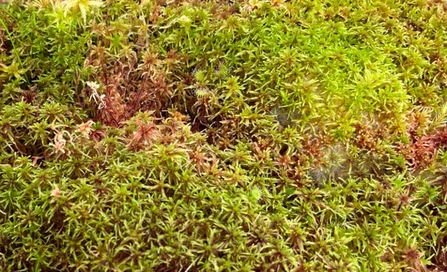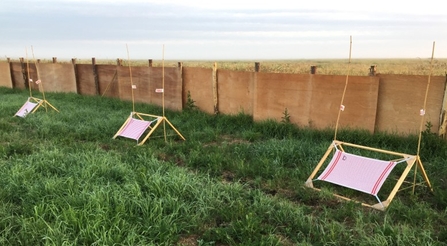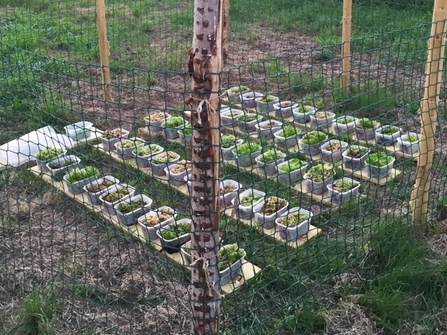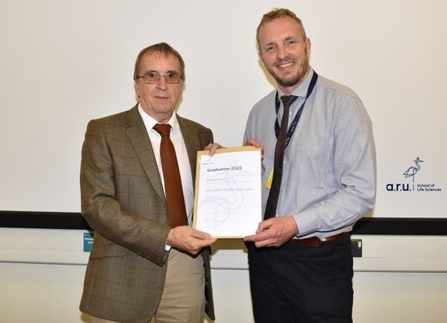In my last blog I wrote about my year as a Great Fen Volunteer Officer. Since then I have successfully completed my MSc in Applied Wildlife Conservation at Anglia Ruskin University. For my master’s project I wanted to study some aspect of peatland restoration, due to its importance in relation to atmospheric carbon emissions, biodiversity gain, and sustainable farming. After discussions with the Wildlife Trust's Great Fen team, I decided to investigate the role of ‘occult precipitation’ as a moisture pathway for sustaining sphagnum moss in areas of lower rainfall, such as the Cambridgeshire fens. (Occult precipitation is defined as mist and dew moisture deposits not recorded by standard weather station equipment).
Project investigating sphagnum moss, mist and dew leads to award
Occult mist over the Great Fen - Martin Parsons

Occult mist over the Great Fen - Martin Parsons
Cambridgeshire has an annual rainfall of about 600mm on average, although this varies considerably from year to year. Cambridgeshire also holds much of the remaining fenland peat soil, and sphagnum moss is an important genus in the formation of peat. Sphagnum can thrive in areas where there is 1000mm or more of rainfall, or elsewhere if additional water is available. It was previously much more abundant in Cambridgeshire, so the main task was to investigate the role of occult precipitation as a moisture pathway for sphagnum. The second task was to select and investigate ten suitable species, and establish which might be best evolved to take advantage of occult precipitation. A third task was to investigate whether hedges could have the effect of slowing air movement and thereby cause an increase in mist density.
There are thirty-eight sphagnum species found in the British Isles, of which nineteen are most widespread and common, and five of these are already being trialled in the Great Fen paludiculture project. After consideration of the prevailing environment, climate and species abundance, ten species were carefully selected for the study, and samples located by a skilled ecologist working in the Scottish Highlands. With landowner permissions obtained, a small quantity of each species was legally ‘harvested’ in spring last year.
Sphagnum mosses are a fascinating genus. They hold more of the world’s soil carbon store than any other plant genus. They are non-vascular, and require only air, light and water in order to grow. Nutrients are taken from the water supply (rainwater in bogs, groundwater in fens). With no internal waterways, sphagnum mosses rely on intricate external capillary films to take moisture up to the growing tip, called the capitula. Sphagnum capitulum often form a carpet, with each capitula at approximately the same height as its neighbours. This is because if one capitula gets too far ahead, its water supply will be reduced and its growth will slow. On the other hand, if a capitula gets left behind it receives less light, and etiolation causes it to grow faster and hence it catches up with its neighbours. Establishing a capitula carpet allows water to be shared through both vertically and laterally. This is so important that sphagnum can prioritise establishing a capitula carpet over vertical growth.
All species of sphagnum can live near the water table given no competition, however different species have evolved to occupy ecological niches at different heights above the water table. These species can be categorised as ‘pool’, ‘carpet’, ‘lawn’ or ‘hummock’ species.

Sphagnum moss with a well-formed capitula carpet
In a functioning mire (i.e. a place where fresh peat is still accumulating) there are two layers found below the capitula carpet. First is a white spongy layer of living sphagnum known as the acrotelm layer. In a healthy mire it will be water-logged, and able to hold vast reserves of water in order to sustain itself in times of drought. Below this is the dark layer of dead peat known as the catotelm. About 1mm of new peat is laid down to the catotelm each year, so one meter of peat takes about a thousand years to accumulate.
The challenge of re-establishing sphagnum on drained black peat is really one of recreating a functioning acrotelm layer. Sphagnum is a key-stone species, and once established acts as an eco-system engineer by acidifying the water around it. This process results in local water with pH values as low as pH4 or even pH3.5, which prevents many vascular plants from competing. Sphagnum also retains a high portion of any minerals that it extracts from its water supply, and rots down very slowly. In order to survive alongside sphagnum, some plants such as round-leaved sundew (Drosera rotundifolia), supplement their nutritional intake by trapping small invertebrates. (You might be able to spot some sundew showing in the sphagnum capitula carpet image above).

The wooden hedge and home-made mist-catchers - Martin Parsons
Project field trials were planned for June 2022. With no suitable hedge available on the fen, a 37m pseudo “wooden hedge” was constructed using 8’x4’ plyboard and some spare borrowed fence posts. Six mist-catchers were constructed using uniform tea-towels suspended in purpose-built wooden frames. The ten sphagnum mosses were each split into five light-weight plastic boxes, with a spray of rain water applied occasionally to avoid desiccation. Through June 2022, ten suitable nights were selected for field trials. For each trial, the sphagnum samples were weighed and laid out at sunset, and then weighed again at sunrise.
Mist and dew form at the end of a day when wind speed is low and also there is a significant drop in temperature, causing the relative humidity to go high. Twelve months of on-site weather data was collected (courtesy of the UK Centre for Ecology & Hydrology [UK-CEH]) and analysed to establish how often occult precipitation is likely to occur; and about one night in three appears a reasonable deduction.

Sphagnum samples laid out in test boxes for a field trial, with mesh surround to exclude local wildlife - Martin Parsons
The results showed that all the sphagnum samples increased in weight by a similar extent during ‘damp and misty nights’, which is due to the similar size of boxes and exposed surface areas. However, during other nights when conditions were ‘warm and wind’ with no or very little mist and dew, there were significant variations in the ability of different sphagnum species to retain the local moisture present.
Regarding the key question of which sphagnum species are best adapted to capture and retain occult precipitation, the result was interesting in that the top three performers included one ‘hummock’ species, one ‘lawn’ species, and one ‘carpet’ species. Only a minor difference in mist intensity was detected by the ‘in-field’ and ‘near-hedge’ mist catchers, suggesting that hedges do not provide a significant benefit mist formation. However, a very strong correlation was observed when comparing the moisture gained (in mass per unit area) between the boxes of sphagnum and the adjacent mist catchers, which suggests a robust and credible experimental methodology.
There may yet be a paper to be written on this study, so for that reason I hope you will forgive me for not detailing more specific results. If you would like to know more about the species I worked with, please get in touch via the Great Fen team.
A surprise ending to the adventure was a recent invitation to attend the ARU School of Life Sciences Award Ceremony to collect a ‘Best Student – MSc Applied Wildlife Conservation award’. This was both an honour and completely unexpected since the awards are not advertised in advance.

Martin Parsons collecting his award for Best Student MSc Applied Wildlife Conservation from Dr. Jim Littlemore. (Image credit Anglia Ruskin University)
Kate Carver, Great Fen Project Manager said, "The Great Fen team are delighted that Martin’s MSc field project has been recognised by this prestigious award from Anglia Ruskin University, and that he chose to undertake it on the Great Fen. Occult precipitation is such a fascinating yet little known phenomena, just the exotic name inspires interest from non-technical audiences. Martin’s research adds to the body of knowledge for technical audiences, and will be of interest to peatland academics, scientists and conservationists alike in understanding how sphagnum moss benefits from this additional source of atmospheric moisture and which species of moss here on the Great Fen benefit most. Martin allied rigorous academic analysis with an ingenuity derived, one suspects, from his engineering background (I’ll never regard tea towels in exactly the same way), exemplifying the best sort of enquiring and original research for which the Great Fen has a growing reputation. Congratulations Martin and thank you for adding to our body of knowledge."
For the future, I will be looking for opportunities to make a further contribution to lowland peat restoration, which is now an area of conservation attracting significant attention and funding. As an illustration of this, the forthcoming IUCN UK Peatland Programme conference to be held at Ely in October this year bears testimony to the importance of peatland restoration in the Cambridgeshire fens and surrounding areas.
Acknowledgements: I would like to thank Calum Urquhart for his expert assistance gathering the sphagnum moss. Lorna, Nicky and Dave for gatekeeper permissions and assistance with the wooden hedge assembly. UK CEH for access to the weather station data. Langdyke Countryside Trust for the loan of the fence posts. And finally, Brian Eversham for championing the project, and Dr ‘Bas’ Boots from ARU for acting as project supervisor.






